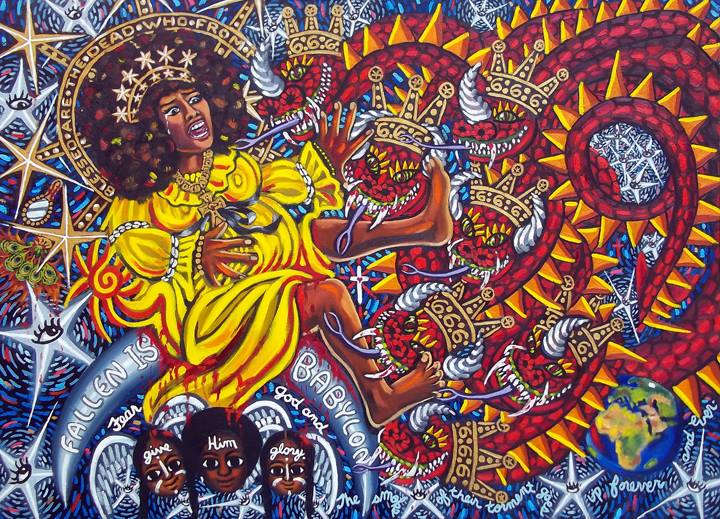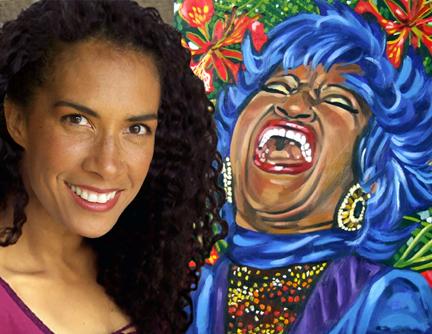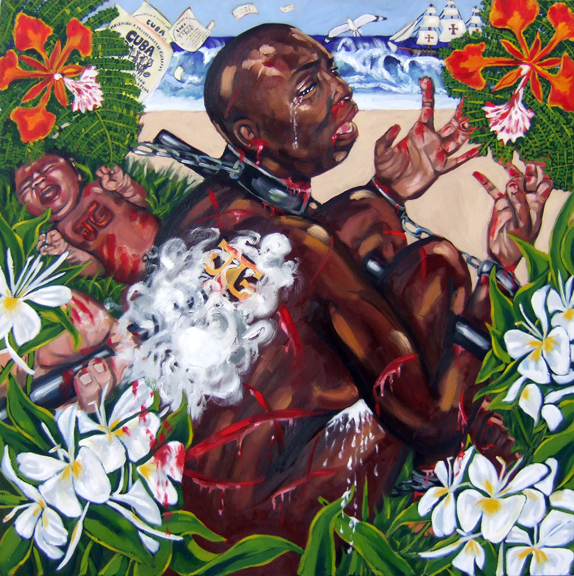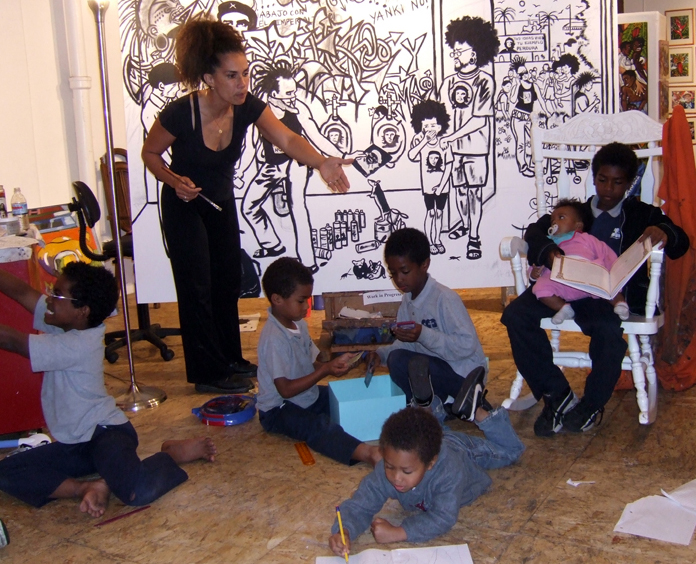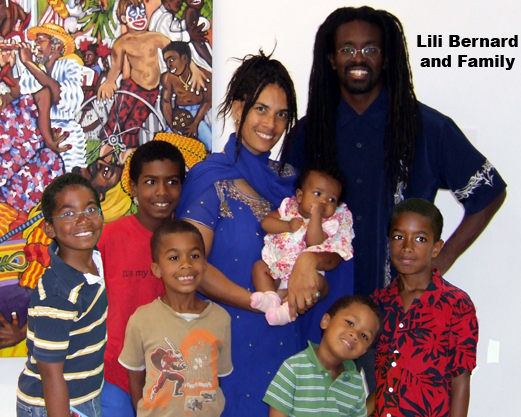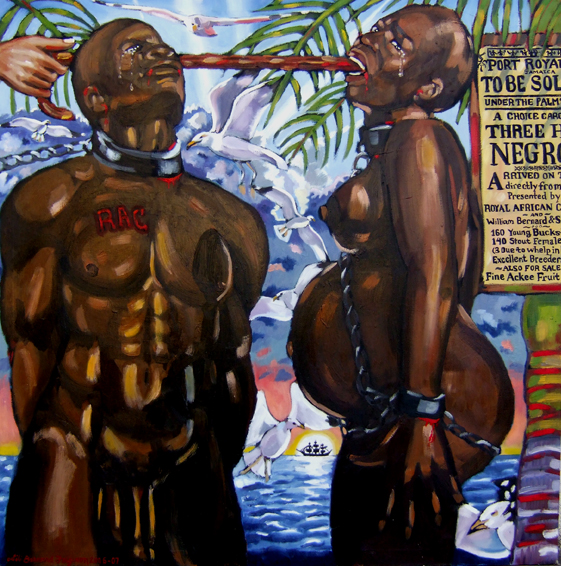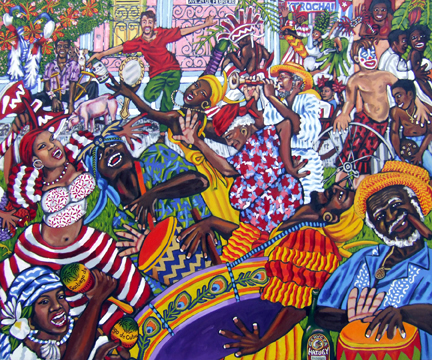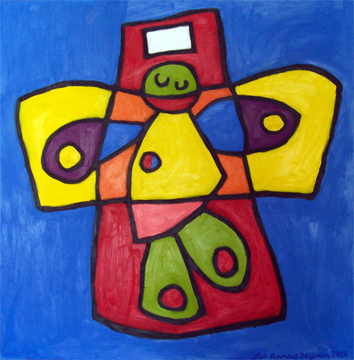Afro-Cuban American artist Lili Bernard’s life is as colorful as her paintings. Being on a hiatus from a successful acting career (Golden Years, The Cosby Show, Seinfeld) and having become a mother of six, she continues painting at her studio in Chinatown, Los Angeles. In this interview she shares her thoughts about her work, life, and being a woman.
This painting is my interpretation of the birth of Christ, according to the Book of Revelation, syncretized with imagery of Afro-Cuban folklore. Following is the scripture from the book of Revelation upon which I base this painting:
The three angels I painted here are Los Tres Juanitos, the two indigenous Cuban brothers, Juan and Rodrigo De Hoyos, and the little Afro-Cuban slave boy, Juan Moreno, to whom the Virgin Mary (known as La Virgen de La Caridad del Cobre) appeared in Cuba around 1612.
In Santeria, the religion which arose from the mixture of Christianity and the Ifá religion of the African slaves; Caridad is syncretized with the Orisha Ochun. An Orisha is a Yoruba deity, a spiritual manifestation of Olodumare who is God. The mirror, peacock feather fan, stars, cowries, yellow dress and pregnant belly are all symbols which pertain to Ochun.
http://mariaviidalepp.wordpress.com/elu/lili-bernard-an-interview/
Revelation 12:1-3 “A great sign appeared in heaven: a woman clothed with the sun, and the moon under her feet, and on her head a crown of twelve stars; and she was with child; and she cried out, being in labor and in pain to give birth. Then another sign appeared in heaven: and behold, a great red dragon having seven heads and ten horns, and on his heads were seven diadems. “
Revelation 13:16 “And he causes all, the small and the great, and the rich and the poor, and the free men and the slaves, to be given a mark on their right hand or on their forehead, and he provides that no one will be able to buy or to sell, except the one who has the mark, either the name of the beast or the number of his name. Here is wisdom. Let him who has understanding calculate the number of the beast, for the number is that of a man; and his number is six hundred and sixty-six.”
Revelation 12:4 “And his tail swept away a third of the stars of heaven and threw them to the earth. And the dragon stood before the woman who was about to give birth, so that when she gave birth he might devour her child.”
Revelation 14:6-8 “And I saw another angel flying in midheaven, having an eternal gospel to preach to those who live on the earth, and to every nation and tribe and tongue and people; and he said with a loud voice, “FEAR GOD AND GIVE HIM GLORY, because the hour of His judgment has come; worship Him who made the heaven and the earth and sea and springs of waters.”
And another angel, a second one, followed, saying, “Fallen, FALLEN IS BABYLON the great, she who has made all the nations drink of the wine of the passion of her immorality.”
Then another angel, a third one, followed them, saying with a loud voice . . .”
Revelation 14:9 “Then another angel, a third one, followed them, saying with a loud voice, “If anyone worships the beast and his image, and receives a mark on his forehead or on his hand, he also will drink of the wine of the wrath of God, which is mixed in full strength in the cup of His anger; and he will be tormented with fire and brimstone in the presence of the holy angels and in the presence of the Lamb. And THE SMOKE OF THEIR TORMENT GOES UP FOREVER AND EVER; they have no rest day and night, those who worship the beast and his image, and whoever receives the mark of his name.” Here is the perseverance of the saints who keep the commandments of God and their faith in Jesus.”
Revelation 14:13 “And I heard a voice from heaven, saying, “Write, ‘Blessed are the dead who die in the Lord from now on!’” “Yes,” says the Spirit, “so that they may rest from their labors, for their deeds follow with them.”
-M.R
>via: https://www.facebook.com/wobcknowledgeofself?hc_location=timeline
__________________________
January 2010
An Interview with LILI BERNARD
SCENES ON CANVAS
Text: Maria Viidalepp/ Photos: Private Collection/Media: Heart International Arts Magazine
Afro-Cuban American artist Lili Bernard’s life is as colorful as her paintings. Being on a hiatus from a successful acting career (Golden Years, The Cosby Show, Seinfeld) and having become a mother of six, she continues painting at her studio in Chinatown, Los Angeles. In this interview she shares her thoughts about her work, life, and being a woman.
Q: You’ve always had two big passions in your life – painting and acting? Have you always thought of yourself mainly as of a painter and an actor or are painting and acting just two ways among many to express yourself?
A: That’s a very good question. I’ve always thought of myself both as of a painter and an actor. There have been, however, times in my life when I’ve focused more on one medium than the other. For example, giving birth to six children in a ten-year span dictated that I’ve had to concentrate more on painting and less on acting for the mere reason that it would be daunting or at least challenging to try to get to auditions or rehearsals on time. Painting is something that I can do with the six children around me. I nurse the baby at the easel, while I stroke the canvas, and can incorporate the children and their indoor activities into the work environment at my art studio. The same could not be true, if I were a regular on a TV series, though I would welcome the work, of course! I’ve therefore been on a hiatus from acting professionally for about eleven years. Lately, I’ve incorporated my acting with my painting, through a multi-media work-in-progress which I call Ceiba de Cuba. It is a years-long project, in an embryonic stage, which weaves together my paintings, poetry, videography, playwriting and drama into one on-stage performance that tells stories which revolve around my being an Afro-Cuban expatriate of mixed heritage. With regard to the medium or genre in which I’ve been most prolific and upon which my soul depends most for its artistic expression — I would have to say, it’s painting. I definitely feel that I would literally die if I could not paint. I would find a way to continue painting, even if I had no sight, God forbid. I cannot say the same for acting, though I love the craft very deeply.
Q: Your paintings are all very expressive, emotional, and intimate: they tell stories and look like movie scenes. Do you think that your being an actress has influenced you a lot as a painter? Have you ever considered working as a movie director?
A: Absolutely! My acting has impacted my painting and vice versa. I would love to direct a movie one day, though it would probably be a grassroots no-budget project. I have some close friends who are real professional filmmakers and so I’m familiar with all the steps they had to take to get to where they are. I wouldn’t pretend to ever be able to do what they do without a lot of hard work, preparation and experience of which I have none. In the meantime, I’ve been having fun directing and editing my friends in the little vignettes that I put together for the videography in Ceiba de Cuba.
Q: You are as charismatic as the Mexican artist Frida Kahlo, if you allow me the comparison. Has she or anyone else influenced the way you think about and do art?
A: Wow! What a compliment! How flattering! I love Frida Kahlo. Yes, she inspires my art; I have several books on her and have looked at her paintings for hours at a time. Her work is so sincere and vulnerable, yet powerful. I also have a strange relationship with Frida Kahlo’s biographical portraits, because I have been so prolific in an important aspect of life in which Frida Kahlo (to her profound chagrin) was not – childbirth. So her paintings speak to me in a most empathetic way. However, to tell you the truth, the ones who have influenced most the way I think about and do art are my parents and my children. From a very early age, my mom and dad have always nurtured my gift and to this day they continue to inspire my work by sharing information about my ancestry and my “Cubanismo” which feeds my artistic output. My children are by far my greatest earthly inspiration and my best critics when it comes to creating art. I’ve also been inspired by their own artistic work which is so pure and uninhibited. Spiritually, my father’s father, Abuelo José is a great inspiration in my work. He was a Mambí, an insurgent soldier in Cuba’s war of independence from Spain, a war correspondent, an author and a poet, an evangelical pastor who started and ran churches in Cuba and Jamaica, and a painter. I do believe that his spirit puts paintings and poetry in my mind while I sleep. I awake with images of completed paintings in my head or long poems that I’ve committed to memory in my dreams. It’s a really efficient step in producing art, through my dreams while I sleep. It becomes a matter of executing the images on canvas or typing the poems into my computer and performing the spoken word on stage. The work then flows out of me like a waterfall, without my really trying. I race with the limitations of time and with the obligations of parenting to create my art which has already been created in my head.
Q: You are married and have six (!) children. How do you manage to divide your time between being an artist and being a wife and mother?
A: I don’t sleep much. That’s the key! Some times, in one week, I pull two all-nighters, with nights of one or two or three hours of sleep in between! Then by the end of the week, I feel like I’m going to die of a heart-attack and I will sleep six or eight hours on that night. And it repeats like that, cyclically. Although I’ve been operating like that for several years now, I know that it’s transitory, that it will stop when my children are grown and gone. I know that if it weren’t for the responsibility, which I relish, of taking care of my six young children during the day; I wouldn’t be doing this. I wouldn’t be suffering like this for my art — nor, however, would I be painting so much. My children truly do impel me to create. There is also a real need to assist my husband in providing for our children. This is also a motivation. The sales of my paintings have helped with that. I watched my parents juggle six children and their careers and provide for us a wonderful life. My parents inspire me greatly to try and do the same, to stay true to my artistic career while being a responsible parent who, along with her husband, provides for the need of her children.
Q: Your studio in Chinatown also functions as a nonprofit art gallery called HABLA Underground which features besides your own work also the work of other artists. Could you tell me a bit more about why you’ve created the gallery and your future plans with it?
A: I created HABLA (Harvesting Asian Black Latino Artists), almost three years ago because it had become apparent to me that there is a terrible dearth in the main-stream art world of artists of color and of artwork in general that represents themes and images outside of the White realm. At first, the program revolved around youth mentoring. Last summer, I incorporated an adult artist collaborative. We call ourselves HABLA Underground, because the gallery we occupy is located in the basement of my art studio. Before, my children used to just play in that space, now it’s dedicated to the collaborative. The idea in bringing adult artists together is to share with other artists, regardless of their ethnic makeup, the platform that I have enjoyed for almost three years now, in having an art studio located in a premier, world-famous art gallery district. Rather than complaining about the situation in lack of representation for colored folk and rather than trying to chase down galleries, art dealers or museums that are not interested in representing our work or in taking the “risk” in doing so; we have created our own platform, our own shows, our own vehicle of exposure. Our collaborative is comprised of people of all ethnicities, including Caucasian. We work together as a family with a mutual interest in getting our work out to the public.
Look for more www.lilibernard.com
The artist about her paintings:
Homage to my Afro-Jamaican Ancestors:
This painting is a eulogy to both of my Jamaican grandmothers’ forbearers who were sold on the auction block in Jamaica. I made that painting in just six hours, crying a lot and feeling the spirits of my ancestors in the room with me. I related most profoundly to the pregnant woman on the block and tried to show the dignity and hope that my ancestors maintained, despite the attempt of their oppressors to strip it away. I feel that I owe a lot to my ancestors, that I am their dream come true. I don’t want to let them down, so I keep toiling away through my artistic expression to try and help bring about some positive change to the world, if I humbly may, in how ever small a way.
Both of my grandmothers were born in Kingston, Jamaica. In 2004, my dad, my brother Dan, and my sister Alicia and her family went to Jamaica to conduct research on our Jamaican ancestry. While there, Alicia took a snapshot of a bronze statue of a nude man and woman, facing one another, which graces the entrance of Emancipation Park in New Kingston. The statue is by artist Laura Facey Cooperand is entitled “Redemption Song,” after Bob Marley. According to the artist, the figures represent emancipated slaves. Below the sculpture appears a portion of the lyrics from Bob Marley’s “Redemption Song.” The words, inspired by the teachings of the legendary Jamaican, Marcus Garvey, read, “…none but ourselves can free our mind.”
When I saw the photo of this sculpture, I imagined the slave couple prior to their emancipation, at the point of their forced entry into Jamaica. Instead of standing in newly liberated nudeness, free from the rags and chains of their enslavement; I envisioned them bound naked in iron, freshly branded, and being inspected invasively on the auction block in Port Royal Jamaica, where inevitably my Jamaican forefathers were sold in bondage to slavery. My imaginings led to this painting. The initials RAC, branded on the man’s breast, stand for the Royal African Company, one of the largest slave trading companies in Jamaica.
-M.R
Carnaval en La Trocha:
In this painting I tried to grasp some of that beautiful spirit of the Afro-Cuban people on the island which I left as a toddler – a spirit that is illuminated through their music and dance, through the colors that they wear. Theirs is a joy that radiates from deep within, despite the poverty surrounding them and the generations of subjugation and oppression from which they sprung and which they still endure in Cuba. That painting is also filled with images of Santeria, Cuba’s Afro-Cuban religion, born of the Yoruba culture, the Ifá religion of the slaves, mixed with the Christianity which the slave masters imposed upon them. I’m not initiated into the religion, but I’m drawn to it, as a Christian and as an Afro-Cuban.
Elias’s Christ:
The story behind Elias’s Christ is one of my most sensitive ones. My son Elias has helped me to look at the glass half full as opposed to half empty. When he first lost his hearing in his right ear, at the age of four, from a virus; I mourned the loss tremendously. The hearing los was accompanied with temporary unilateral paralysis of the face, which was debilitating for him. Now, I am just so grateful that his face is no longer paralyzed and that he can hear at all, that he can enjoy the sounds that he hears through his left ear, and dance to them, that he is able to speak and communicate well, that he is healthy and strong, and growing. It has not been a hindrance for Elias in having hearing in only one ear. He excels in all aspects of life, including academics, sports, music and art. That painting is very special, because we created it together, shortly after the crisis. The very simple and beautiful image of Christ on the cross came to Elias on paper and pencil, when we were in church. Later, at home, I elaborated Elias’ image, by adding color and some other aspects, but it’s still his image, his vision of Christ. That’s why I call it Elias’ Christ.
>via: http://mariaviidalepp.wordpress.com/elu/lili-bernard-an-interview/

